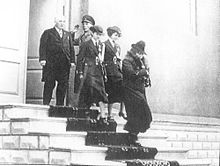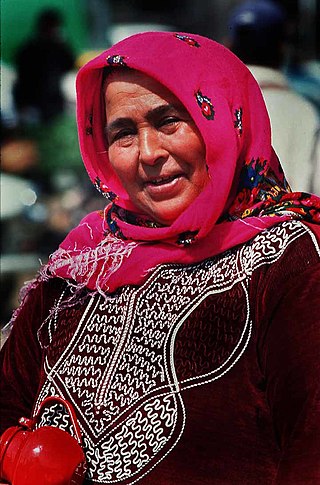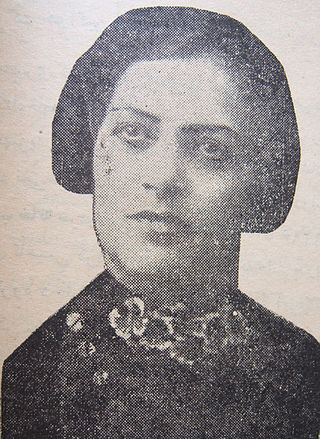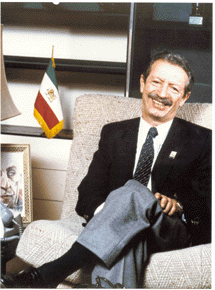History
Muslims conquered Iran in the time of Umar (637 CE) and Iranians were reportedly among the very earliest converts to Islam and adopted Muslim customs such as hijab. During the Middle Ages, Turkic nomadic tribes from Central Asia arrived, whose women did not wear headscarves. [6] [7]
Safavid dynasty
After the Safavid (from 1501 to 1736) centralization in the 16th century, the headscarf became defined as the standard headdress for many religious women in urban areas all around the Iranian Empire. [8] Exceptions to this were seen only in the villages and among nomadic tribes, [6] [7] [9] [10] [11] such as Qashqai. Covering the whole face was rare among the Iranians and was mostly restricted to local Arabs and local Afghans.
However, hijab was not uniform and monolithic in Safavid Iran. Women from different ethnic and religious groups wore different styles and colors of veils and headscarves, reflecting their regional and cultural identities. [12] Some women also wore hats, turbans, and bonnets, influenced by European fashion.
The Safavid court was also a place of diversity and splendor in terms of clothing. The royal women wore elaborate and luxurious garments, made of silk, velvet, brocade, and fur, embroidered with gold and silver, and adorned with jewels and pearls. They also wore different types of head coverings, such as mandils (turban material), qalānsūwas (conical caps), and tāj (crowns). [13]

Qajar dynasty
During Qajar dynasty the hijab was a prevalent fashion choice for women in Iran, as it reflected the cultural, religious, and political identity of the Qajar empire. The hijab was enforced by the Islamic dress code for women, which was introduced by the Safavid dynasty and continued by the Qajars. [14] The hijab was often made of colorful and patterned fabrics, and sometimes adorned with pearls, feathers, or flowers, however, In the later Qajar period, women’s clothing became more elaborate and diverse, reflecting the influence of European styles and fabrics. Women wore long dresses with tight waists and wide skirts, often made of silk, velvet, or brocade. They also wore jackets, vests, and shawls over their dresses, and decorated their outfits with embroidery, lace, ribbons, and jewels. [15] [16]
The Qajar dynasty faced many internal and external challenges and pressures, such as the constitutional revolution, the tobacco protest, and the Anglo-Russian agreement. These events affected the lives and roles of women in Iran, who participated in various social and political movements, such as the women’s awakening, the women’s association, and the women’s parliament. Some women also advocated for women’s rights and education, such as Bibi Khanum Astarabadi, Tuba Azmudeh, and Sediqeh Dowlatabadi. [13] during the economic crisis in the late 19th century under the Qajar dynasty, the poorest religious urban women [17] could not afford headscarves, [9] [18] therefore Women were protected, secluded in the home or had to wear chador. [17]

Pahlavi dynasty
In the 1920s, a few individual Iranian women started to appear unveiled, despite the cultural pressure to veil. In 1924, the singer Qamar-ol-Moluk Vaziri broke gender segregation and seclusion by performing unveiled in the gender-mixed company at the Grand Hotel in Tehran, and the Royal Palace Theater. [19] Reza Shah, a military officer who supported "Westernized women active outside the home" and opposed the influence of religious clerics, came to power in December 1925. [20] Iranian women's rights activists supported the unveiling, and the feminist Sediqeh Dowlatabadi is believed to have been the first woman in Iran to have appeared in public without the veil in 1928. [21] [22] To appear without a veil or even favor it in public debate was very controversial, and women's rights activists who spoke in favor of unveiling sometimes had to be protected by the police. [23] In 1926, the Shah specifically provided police protection for individual women who appeared unveiled but with a scarf or a hat to cover the hair. [24]
In 1928, the Queen of Afghanistan, Soraya Tarzi, appeared unveiled publicly with the Shah during her official visit to Iran. The clergy protested and asked the Shah to tell the foreign queen to cover up, but he refused. His refusal caused rumors that the Shah planned to abolish the veil in Iran. In 1928, Shah's wife, queen (Tadj ol-Molouk) attended the Fatima Masumeh Shrine during her pilgrimage in Qom wearing a veil that did not cover her completely, as well as showing her face, for which a cleric harshly criticized her. [25] As a response, Reza Shah publicly beat the cleric who had criticised the queen the next day. [25]
As a method of the modernization of the country, and following the example of Mustafa Kemal Atatürk in Turkey, the shah encouraged women's participation in society. [26] The veiling of women which would have huge symbolic importance in towards this and women's emancipation in general, but the shah introduced the reform gradually so as not to cause unrest. [26]
Female teachers were encouraged to unveil in 1933, and schoolgirls and women students in 1935. [26] The reform not only allowed female teachers and students not to veil, but allowed female students to study alongside men. All these reforms were opposed and criticized by the Shia clergy. [25]
In 1935, the women's committee Kanun-e Banuvan (Ladies Society) was formed with the support of the government. [27] The committee's women's rights activists campaigned for unveiling. [26]
Kashf-e hijab

On 8 January 1936, [28] Reza Shah issued a decree, Kashf-e hijab, banning all veils. [29] The official declaration of unveiling were made on 8 January 1936, and the queen and her daughters were given an important role in this event. [26] That day, Reza Shah attended the graduation ceremony of the Tehran Teacher's College with the queen and their two daughters unveiled and dressed in modern clothes. [26] The queen handed out diplomas while the shah spoke about how in the past half of Iran's population had been disregarded, and told the women graduates that the future was now in their hands. [26] This was the first time an Iranian queen had shown herself in public. Afterwards, the Shah published pictures of his unveiled wife and daughters, and the unveiling was enforced throughout Iran. [26] To enforce this decree, the police were ordered to physically remove the veil from any women who wore it publicly. [30] As a result, many pious traditionalist women chose not leave their houses to avoid confrontations, [31] [10] and a few conservative women even committed suicide to avoid removing their hijabs due to the decree. [31]
The ban was left in place for five years, until Reza Shah was deposed 1941. The Iranian women's movement had generally favored unveiling, [32] and many of Iran's leading feminists and women's rights activists organized in the Kanun-e Banuvan to campaign in favor of the Kashf-e hijab, among them Hajar Tarbiat, Khadijeh Afzal Vaziri and Sediqeh Dowlatabadi, Farrokhroo Parsa and Parvin E'tesami. [33]
Religious conservatives reacted with outrage to the reform. According to Iran's current Supreme Leader Ali Khamenei, the policy was aimed at "eradicating the tremendous power of faith" in Muslim societies that was enabled by what he termed the "decency of women", as hijab (in his view) protected Muslim women from the "malicious abuse" suffered by women in the West, and the people from preoccupation with sexual desire. [34]
Mohammad Reza Pahlavi
Kashf-e hijab was relaxed in 1941 under Reza Shah's successor (and son), Mohammad Reza Pahlavi; the wearing of a headscarf or chador was no longer an offense and women were able to dress as they wished, [35] but hijab was still considered an indicator of backwardness or of membership of the lower class. Wearing of the chador became a significant hindrance to climbing the social ladder. [36] Veiled women were assumed to be from conservative religious families with limited education, while unveiled women were assumed to be from the educated and professional upper or middle class. [35] Professional middle-class women such as teachers and nurses appeared unveiled in their work place, but sometimes veiled when they returned home to their families. [26]
Discrimination against women wearing the headscarf or chador occurred, with some public institutions discouraging their use, and some eating establishments refusing to admit women who wore them. [30] [37]
In the 1970s, the chador was usually a patterned or of a lighter color such as white or beige; black chadors were typically reserved for mourning and only became more acceptable everyday wear starting in the mid-1970s—however in the period before the Iranian Revolution the black chador's usage outside of the city of Qom was associated with allegiance with political Islam and was stigmatized by areas of Iranian society.
During this era, traditionalists such as the Devotees of Islam (Fedāʾīān-e Eslām) demanded mandatory veiling and a ban on unveiled women, but their efforts failed. [33]
Islamic Republic era
Opposition to the Shah and Westernization
Leading up to the Islamic Revolution of 1979, the wearing of hijab by educated middle-class women began to become a political symbol—an indication of opposition to the Pahlavi modernization policy and thus of Pahlavi rule. [36] Many middle-class working women starting to use it as such. [36]
Not only simple hijab but the traditional Shi'i chador became popular among the middle class opposition, as a symbol of revolutionary advocacy for the poor, as protest of the treatment of women as sex objects, to show solidarity with the conservative women who always wore them, and as a nationalist rejection of foreign influence.
Hijab was considered by conservative traditionalists as a sign of virtue, and thus unveiled women as the opposite. Rather than a sign of backwardness, unveiled women came to be seen as a symbol of Western cultural colonialism; Westoxication" (Gharbzadegi) or infatuation with western culture, education, art, consumer products etc., "a super-consumer" of products of Imperialism, a propagator of "corrupt Western culture", undermining the traditionalist conception of "morals of society", and as overly dressed up "bourgeois dolls", who had lost their honor. [38] : 144
Feminist hijab advocates pointed out that traditionally women not only wore hijab but did not mix with men, but in the anti-shah demonstrations thousands of veiled women participated in religious processions alongside men, which showed hijab empowered women protecting women from sexual harassment (because conservative men regarded them as more respectable) and enabling access to public spheres. [39]
Islamic Republic

After the Islamic Revolution and founding of the Islamic Republic, the Kashf-e hijab was reversed. Instead of prohibiting veils, the law now required them, [38] a process that worked in stages. [29] In spring of 1979 (shortly after the overthrow), leader of the revolution Ayatollah Ruhollah Khomeini announced that women should observe Islamic dress code. [40] He was supported in his by the conservative/traditionalists fraction of the revolutionaries who were hostile to unveiled women, as expressed in two slogans used during this time: "Wear a veil, or we will punch your head" and "Death to the unveiled". [40]
Non-conservative/traditionalist women, who had worn the veil as a symbol of opposition during the revolution, had not expected veiling to become mandatory. Almost immediately after, starting from 8 March 1979 (International Women's Day), thousands of liberal and leftist women began protesting against mandatory Hijab. [38] [35] The protests lasted six days, until 14 March. The protests resulted in the (temporary) retraction of mandatory veiling, [38] and government assurances that Khomeini's statement was only a recommendation. [29] [41]
Khomeini, denied that any non-hijab wearing women were part of the revolution, telling Italian journalist Oriana Fallaci in February 1979:
"the women who contributed to the revolution were and are women who wear modest clothes. ... these coquettish women, who wear makeup and put their necks, hair and bodies on display in the streets, did not fight the Shah. They have done nothing righteous. They do not know how to be useful, neither to society, nor politically or vocationally. And the reason is because they distract and anger people by exposing themselves." [40]
As the consolidation of power by Khomeini and his core supporters continued, left and liberal organizations, parties, figures, were suppressed and eliminated, and mandatory veiling for all women returned. [38] This began with the 'Islamification of offices' in July 1980, when unveiled women were refused entry to government offices and public buildings, and banned from appearing unveiled at their work places under the risk of being fired. [42] On the streets, unveiled women were attacked by revolutionaries. [40]
















